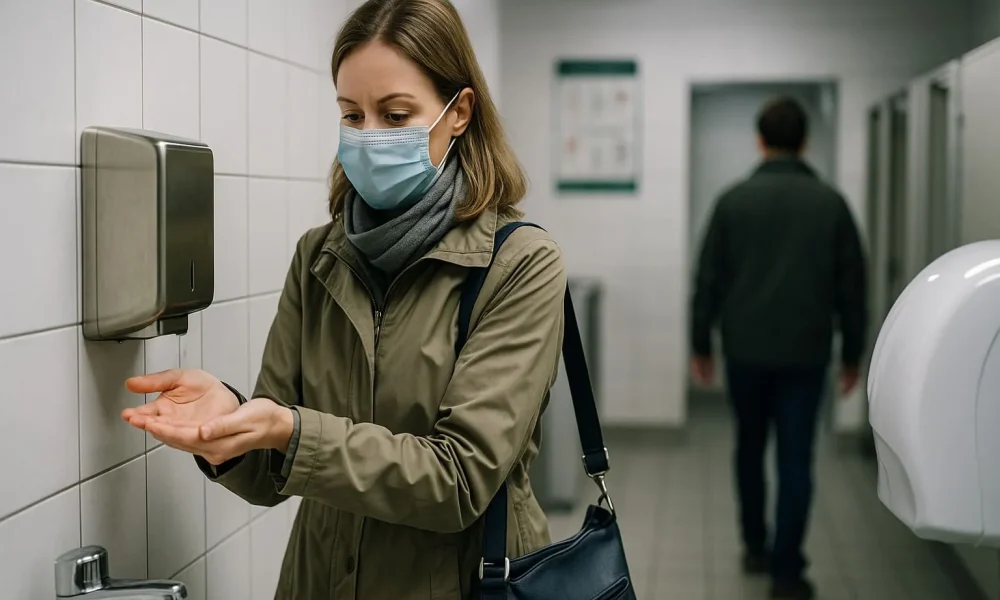Navigating the Germ Jungle: High-Risk Hotspots and How to Stay Safe
We live in a world teeming with microscopic life, some of it friendly, some not so much. And while we can’t live in a bubble (tempting as it might sound sometimes!), understanding where germs tend to congregate can empower us to make informed choices and protect our health. Think of it as navigating a jungle – knowing where the predators lurk is half the battle. So, let’s explore some of these high-risk hotspots and equip ourselves with the knowledge to stay safe.
Public Restrooms: A Germ Gathering
Let’s face it: public restrooms aren’t exactly known for their pristine cleanliness. They’re a high-traffic area, and while many establishments do their best to maintain hygiene, the sheer volume of users makes them a breeding ground for germs. From door handles to faucets, toilet flushers to paper towel dispensers, the surfaces in public restrooms are touched by countless hands, leaving behind a trail of microscopic hitchhikers.
Think about it: you touch the door handle to enter, potentially picking up whatever previous users have left behind. Then you might touch the flusher, the faucet, and maybe even the soap dispenser itself! It’s a chain reaction of potential germ transfer. And let’s not forget the air itself, which can harbor airborne bacteria and viruses, especially in poorly ventilated spaces. It’s like a microscopic party, and you’re not invited.
So, what can you do to protect yourself in this germ-filled environment? First and foremost, hand hygiene is paramount. Wash your hands thoroughly with soap and water for at least 20 seconds, making sure to get between your fingers, under your nails, and the backs of your hands. If soap and water aren’t available, use hand sanitizer with at least 60% alcohol. Avoid touching your face, especially your eyes, nose, and mouth, while you’re in the restroom and immediately after.
Another helpful tip: use a paper towel to turn off the faucet and open the door on your way out. This creates a barrier between your clean hands and potentially contaminated surfaces. And if you have the option, choose a stall that appears cleaner. It might seem obvious, but sometimes a little observation can go a long way.
Public Transport: A Commuter’s Conundrum
Buses, trains, subways – they’re essential for getting us where we need to go, but they’re also confined spaces where germs can easily spread. Think about all those poles, handles, and seats that are touched by countless commuters every day. It’s a recipe for germ transmission. And just like in public restrooms, the air in these enclosed spaces can also be a vehicle for airborne pathogens.
Imagine the rush hour commute: everyone packed together, touching the same surfaces, breathing the same air. It’s a perfect storm for germ sharing. And while we can’t avoid public transport altogether, we can take steps to minimize our risk.
Hand hygiene is crucial here as well. Carry a bottle of hand sanitizer with you and use it frequently, especially after touching surfaces like poles, handles, and seats. Avoid touching your face, and if possible, try to maintain some personal space. This can be tricky during rush hour, but even a little bit of distance can help.
Another strategy is to be mindful of your route and timing. If possible, travel during off-peak hours when the crowds are smaller. This reduces your exposure to germs and makes it easier to maintain personal space. And if you’re feeling unwell, it’s best to stay home and avoid public transport altogether.
Beyond the Usual Suspects: Other High-Risk Areas
While public restrooms and public transport are obvious hotspots, there are other places we encounter in our daily lives that also pose a risk. Think about shopping carts, elevator buttons, and even ATMs. These surfaces are touched by numerous people, making them potential germ havens.
Even seemingly innocuous places like restaurants can harbor germs. Menus, tables, and even salt and pepper shakers can be contaminated. So, it’s important to be mindful of these surfaces and practice good hand hygiene. Wipe down tables before you eat, and consider using hand sanitizer after handling menus or other shared items.
Another often-overlooked area is the workplace. Shared keyboards, mice, and telephones can be breeding grounds for germs. Regularly cleaning and disinfecting these surfaces can help reduce the risk of transmission. And don’t forget about doorknobs, light switches, and other frequently touched surfaces in the office.
The Power of Prevention: Proactive Strategies
Beyond avoiding high-risk places or practicing good hand hygiene, there are other proactive steps we can take to protect ourselves. Maintaining a healthy lifestyle is key. Eating a balanced diet, getting enough sleep, and exercising regularly can strengthen our immune systems and make us less susceptible to infections.
Vaccinations are another important tool in our arsenal. They can protect us from a range of infectious diseases, including the flu and other respiratory illnesses. Staying up-to-date on our vaccinations is a crucial part of staying healthy.
And let’s not forget the importance of staying informed. Keeping up with the latest health recommendations and being aware of any outbreaks in your community can help you make informed decisions about your health. Knowledge is power, especially when it comes to protecting ourselves from germs.
Living in a Germ-Aware World: A Balanced Approach
Navigating the germ-filled world doesn’t mean living in constant fear. It’s about being aware of the risks and taking reasonable precautions. By practicing good hand hygiene, being mindful of high-risk areas, and maintaining a healthy lifestyle, we can minimize our exposure to germs and stay healthy. It’s about finding a balance between being cautious and still enjoying life. After all, we can’t avoid all germs, but we can certainly take steps to protect ourselves. So, stay informed, stay healthy, and keep those hands clean!
